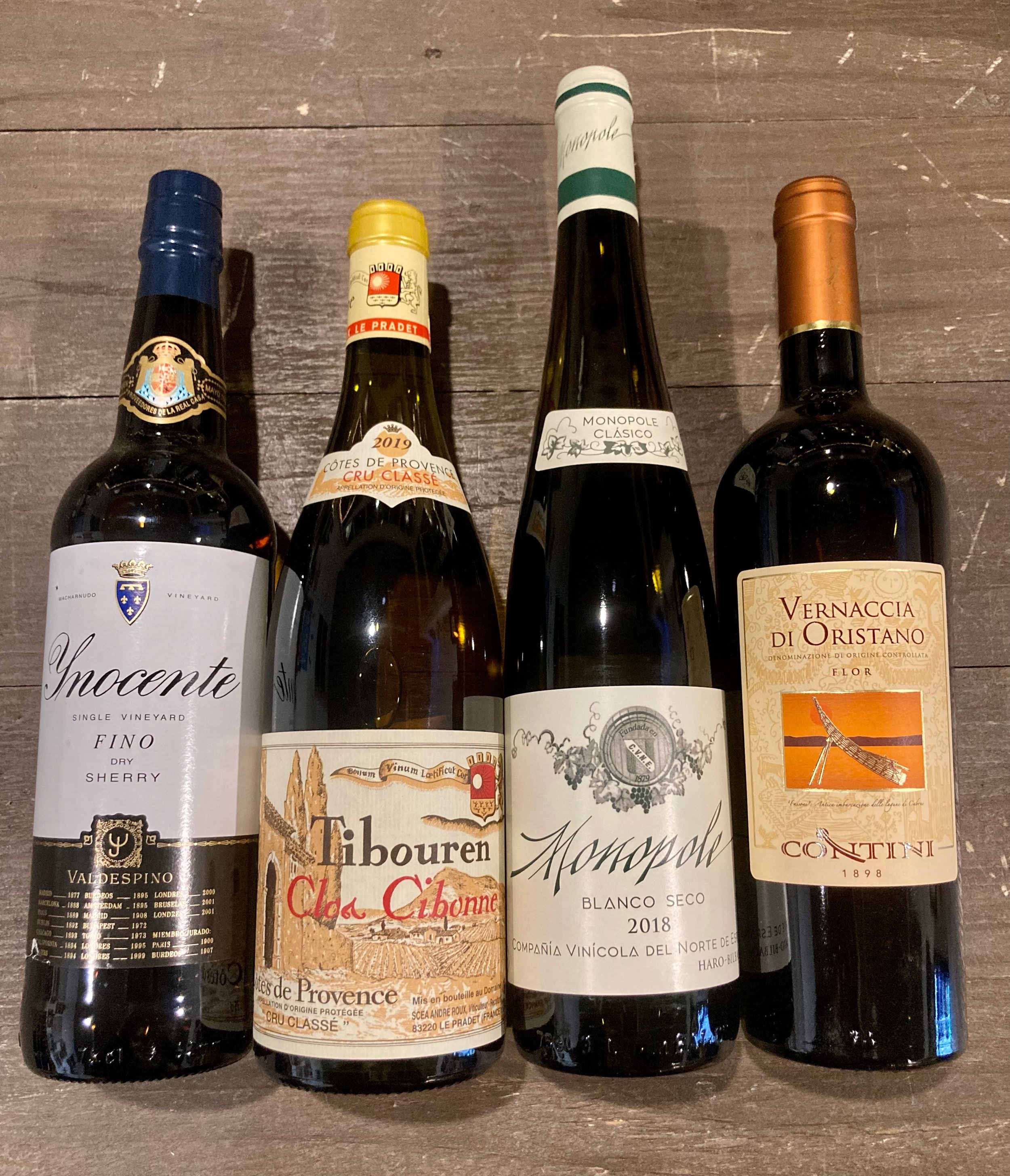Flor is your Friend
From southern Spain’s unoxidized Fino and Manzanilla sherries, to the elusive unicorn Vin Jaune of the Jura, we have the mysterious *FLOR* to thank for the irreplicable style and flavors of some of our favorite wines. Flor got its name from the Spanish word for “flower” and I personally love to think of flor as a living, breathing organism, because it is! - one that’s alive, active, and constantly interacting with the wine it forms on. You see, when the circumstances are right (and boy, are they specific) flor, the yeast known as Saccharomyces cerevisiae, will form - first as white curds, and later taking form as a grey floating biofilm on the surface of wine as it ages in barrel. Even in regions literally built around facilitating the formation of this microscopic organism, flor is never guaranteed, but I believe that fact only adds to the magic.
The yeast cells that comprise the velum, voile, or veil of flor have a waxy, fatty coating on their cell walls, thereby enabling them to float on the surface of the wine. In an anaerobic phase without oxygen, Saccharomyces can ferment sugar like any other yeast more commonly associated with wine, but its second, special phase comes into play only under very precise conditions. In terms of Sherry (by far the most famous biologically-aged wine), the dry base wines are fortified, by adding grape brandy, up to between 14.5 and 16% abv. Any lower, and unwanted microbes can dominate and turn the wine into vinegar. Any higher, and the flor will die, leaving the wine exposed to oxygen. Moderately cool temperatures between 64-68*F, a relative humidity of 70-75%, and constant airflow are all necessary to keep flor healthy and active.
Once the flor has established itself on the surface of your wine, it will consume carbon by way of alcohol and glycerin, and metabolize it in order to live, with the truly rewarding byproducts of acetaldehyde and various other compounds. Oxygen from the air of the empty space of the barrel is actually necessary for this process, which is why these barrels are never completely full, usually only filled to around 80%. Active flor can reduce the alcohol content of a wine by about .25% each year, which might eventually make a diluted, watery wine, but thanks to the evaporation of water content, the dilution is canceled out (which is why wooden barrels are used exclusively, instead of inert stainless steel or other vessels that don’t allow air-exchange). As the flor consumes the glycerin, it lightens up the body and mouthfeel of the wine, making it much less viscous, which is what gives Fino or Manzanilla sherries and other flor-aged wines their lean, light body. Winemakers will periodically top off their barrels (carefully, so as not to disturb the veil) with small portions of unaged wine, to supplement the flor with a steady supply of nutrients. Since the flor floats atop the wine, it in effect protects the wine from ever coming in contact with air, so these wines will remain the very pale color of fresh pressed juice, with virtually no flavors of oxidation. As I mentioned earlier, the most prominent byproduct of these metabolizations is acetaldehyde, which directly influences the aromas and flavors of the finished wines, setting them apart from all other protectively-aged (protected from oxygen, that is) wines, such as an aromatic, youthful, unoaked Riesling or Sauvignon Blanc.
Whew, you made it through the technical stuff!! (Don’t be afraid, we’ll dive a liiiiiittle bit deeper in an upcoming article just about Sherry…). But for now we can talk about the final result of this incredible phenomenon: the compelling, flor-aged wines that we love so dearly. These stunning, biologically-aged wines are often lip-smacking, salty, tangy, and savory all at once. Flavors of apples, nuttiness, and bread dough, which are characteristics more commonly associated with oxidatively-aged wines (such as an oaky California Chardonnay) can also be found in these anomalies of wine, thanks to the acetaldehyde. Here, however, those apple and nut flavors also shine and taste really, really great in the light, crisp, fresh style of these flor-aged wines. Sotolon, another flor byproduct, adds spicy, curried notes and even more nuttiness. Perfectly harmonious with a wide range of food, yet unlike any other table wine you’ve ever had, these rare gems of the wine world are truly in a category unto themselves.
Besides Andalucía in southern Spain, flor can be found anywhere there are pockets where the aforementioned environmental criteria are met: in Southwest France, in eastern alpine France, in South Africa, Australia, also California, Hungary, the list goes on and on… I imagine there are countless wine regions where this biofilm could possibly develop and create such evocative wines, but we might never know for sure, since, understandably so, most winemakers aren’t brave enough to allow an unpredictable moldy film to grow on the surface of their aging wine.
The legendary Vin Jaune wines of the beautiful, remote Jura region (sort of parallel to Burgundy, yet an hour east, towards the Swiss border..) are perhaps the closest stylistically to Spain’s Sherries. However, Vin Jaunes are unfortified, made from the Savagnin grape (Savagnin, not Sauvignon!), and age for about six years under flor, or “sous voile.” They are exceptional in every way. Traditionally drunk after dinner with Comté cheese, these wines are complex, powerful, nutty, and spicy, and one bottle can have an incredibly wide range of flavors, from green apple and peaches, to fennel and flowers, to nuts and toffee. Sadly, we don’t have any presently since they’re so scarce in the United States, but we surely will again once our favorites become available. At this very moment, my favorite flor wines currently gracing our shelves are the following:
Clos Cibonne’s Tibouren Cuvée Tradition is a super-unique Provence rosé, quite unlike the many other pale pink copycats which unfortunately (for them!) all tend to blend together. However, Clos Cibbone is unique in several ways. First, they’re credited with reviving the once-almost-extinct grape varietal Tibouren, which, for the Cuvée Tradition, they blend with 10% Grenache (in order to adhere to Provence wine law), and then age in large, 100-year-old oak foudres, where the wine rests for twelve months under fleurette. With its deep fruit concentration, the added flavors from the flor-aging, and the balance of sharp acidity, this special rosé can age and develop in your cellar for a decade or more. If you really don’t want to wait the ten or so years, try opening or decanting this wine an hour early, before pairing with garlicky shrimp, olives, sardines, or any other Provencal fare.
On the coast of the island of Sardinia, you’ll find the landmark winery of Contini Estate, which was established over 120 years ago. Contini remains true to their history, creating some ancient styles, one of which is their Vernaccia di Oristano ‘Flor’. If the name doesn’t already give it away, the wine is aged up to four years sous voile, in oak and chestnut barrels, called “caratelli,” and this style is certainly one of Italy's most unique wines. Ancient, preserved Vernaccia seeds have been carbon-dated to pre-Phoenician times (!!!!!), so this remarkable varietal may provide our best snapshot to some of the first wines on earth. This wine pours a warm rose gold in your glass, with intriguing aromas of apple cider and mulling spices on the nose. On the palate, it’s exceptionally salty and mouthwatering, with bakery flavors of danish and golden raisin. Only 2000 cases of this wine are made each year, and we’re very excited to have it on our shelves today.
CVNE, (pronounced “coo-nay”) is a famous co-op in the small wine city of Haro, the heart of Rioja. They haven’t made their Monopole Classico for several decades (obviously this one-off style didn’t go along with the international wine market trends) but have since revived it in 2017, after finding some old bottles that have been laying down since the last time it was ever made, in the early 1980s. After rediscovering what a joy this wine once was, they lobbied to change the current local Rioja laws in order to recreate this incredible style of Viura, blended with a portion (12%) of Manzanilla sherry, and then aged in large sherry barrels. I’ve drank this wine with Thanksgiving dinner twice now, and the salty yet fresh wine cuts right through the rich gravy and perfectly refreshes your palate between bites. This wine is so complex and distinctive, and really lives up to any special occasion.
We always try to have a wide selection of Sherry at any given moment, but to get the full effect of flor flavor from one bottle, we suggest trying Valdespino’s Fino Inocente. Made for sipping with Spanish cheese and charcuterie, such as Manchego, chorizo, or Jamon Serrano. Fortified sherry can be the most extreme, volume-eleven style of these flor-aged wines, and is considered by many to be an acquired taste, but with a handful of salted Marcona almonds or a bowl of mixed olives, you’ll better understand the context in which Spanish locals drank this wine for centuries and continue into today!
The biologically-aged style of wines is certainly not beginner level stuff, but with the right guidance and context, they can offer some of the most pleasurable wine experiences of your life. Please don’t be shy.. we love talking about Sherry and other weird wines, answering any questions you may have, and giving tasty recommendations. Thanks for reading!!
— Kim



